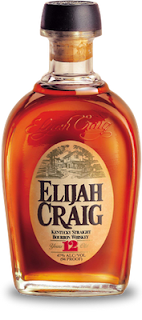Knob Creek Small Batch (Reprint)
Nose: strong vanilla, brown sugar, fresh bread dough, corn and a hint of rye spices, pastries and raisins, which becomes redolent of warm cinnamon rolls with icing, brown sugar vanilla and yeast with a bit of water
Taste: sweet brown sugar and vanilla up front, transitioning to strong rye spiciness, pepper and oak, which becomes a little more subdued honey and corn up front followed by less spicy but more expansive rye and a bit of fruit with water
Finish: primarily rye and cinnamon, fairly long
As I mentioned before, this seems to be Jim Beam's starter for the small batch collection. It clocks in at least a few dollars less than the others. As it gets more volume, it also tends to be on sale more often and can be found for as little as $23 if you look in the right place. It uses the Beam standard 15% rye recipe and shows a good balance between corn, rye and barrel influences. On sale, it's a solid bourbon that can compete well with a lot of other mid-range bourbons. Closer to $40 it's a harder sale, but definitely worth a try.
Basil Hayden
Nose: orange candies, a bit of alcohol, corn sweetness, rye, berries and caramel, which becomes grainier with more vanilla and sweetness, but also somewhat flat and flabby, after the addition of water
Taste: lightly sweet up front, citrus, vanilla throughout, rye spices become apparent from mid-palate to the back of the throat, becomes a bit creamier after water, but also loses what zip it had
Finish: long and lingering rye with a bit of burn and subtle berries and vanilla
Basil Hayden is the same juice as Old Grand Dad, but aged roughly twice as long (8 years vs. 4-or-so years) and significantly diluted down to 80-proof. Ultimately, I feel like it's just not worth it. Basil Hayden will run you at least twice what a bottle of OGD 114 goes for and doesn't pack anywhere near the same punch without bringing anything new to the table. From the copy on the back of the very gussied-up bottle, it sounds like they're trying to make this the more approachable member of the small batch collection by diluting it, but this makes no sense whatsoever to me as you can always bring down the proof in the glass by adding water yourself. I would be very interested to try this bourbon at 90- or 100-proof to see if the extra years in the barrel have contributed much, but as it stands there's just too much water for anything to stand out. Quite a disappointment, so I'm glad that I didn't buy more than the mini.
Baker's
Nose: hot porridge, sweet rye light vanilla, berries, oak, warm caramel and brown sugar, with the grains moving forward and the oak slightly retreating after a few drops of water
Taste: briefly honey sweet up front, quick transition to moderately intense oaky rye spiciness in the middle and mocha near the back, which becomes a bit sweeter with mellower rye and more corn after dilution
Finish: long and lingering rye with a bit of burn, subtle berries, sweet oak and vanilla
This was actually my favorite of the bunch. This bourbon uses the standard Jim Beam mash bill to good effect. The age seems just about right, enough to give some complexity, but not so much that it becomes over-oaked. The 107-proof gives it a solid punch, but not so much that you feel like your mouth is being burned. All of the flavor elements are well balanced, with rye spiciness, sweet vanilla, and oak all in tension, but no one flavor dominating. The mocha flavors are also quite pleasant. With all of that glowing praise though, I'm not sure all of this justifies the usual $50 price tag. There are plenty of bourbons out there that are 80-90% of the experience at 50% the cost.
Booker's
Nose: intense caramel and vanilla, corn and rye grain, with a bit of milk chocolate, which gains brown sugar, wheat and graham crackers as well as and more oak and corn sweetness after the addition of water
Taste: toffee sweet up front, long rye, vanilla and caramel mid-palate, all very robust, which becomes less sweet up front, moving to rye, sweetness and vanilla mid-palate, with chocolate syrup beginning just before the finish and maybe just a hint of pineapple
Finish: a healthy burn with rye, vanilla, and subtle berries
While I don't find it quite as transcendent as others have, this is a very excellent bourbon. At barrel proof, which is usually in the high 120s, this is a beefy bourbon in just about every respect. While it's worth it to take a few sips undiluted, the chemical burn of so much alcohol grows unpleasant fairly quickly and begs for the addition of water to bring it down to a more reasonable point. The strong chocolate flavors are my favorite part of the experience. However, as with the Baker's, I'm not sure that it justifies the $50-60 price tag. Maybe if I had a whole bottle I could make some more precise dilutions and find interesting things around 90- or 100-proof, but there are a lot of other things asking for my money that put Booker's fairly far back in the line.
As I said up at the top, this is best viewed as an experience. It's pretty likely that you'll find different things in these bourbons than I did and given the low cost of admission, I'd say it's worth giving them a go. As a value proposition, the Knob Creek is still my favorite, but others in the collection might just tickle your fancy.






























